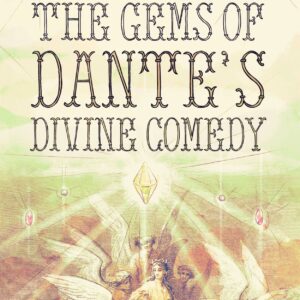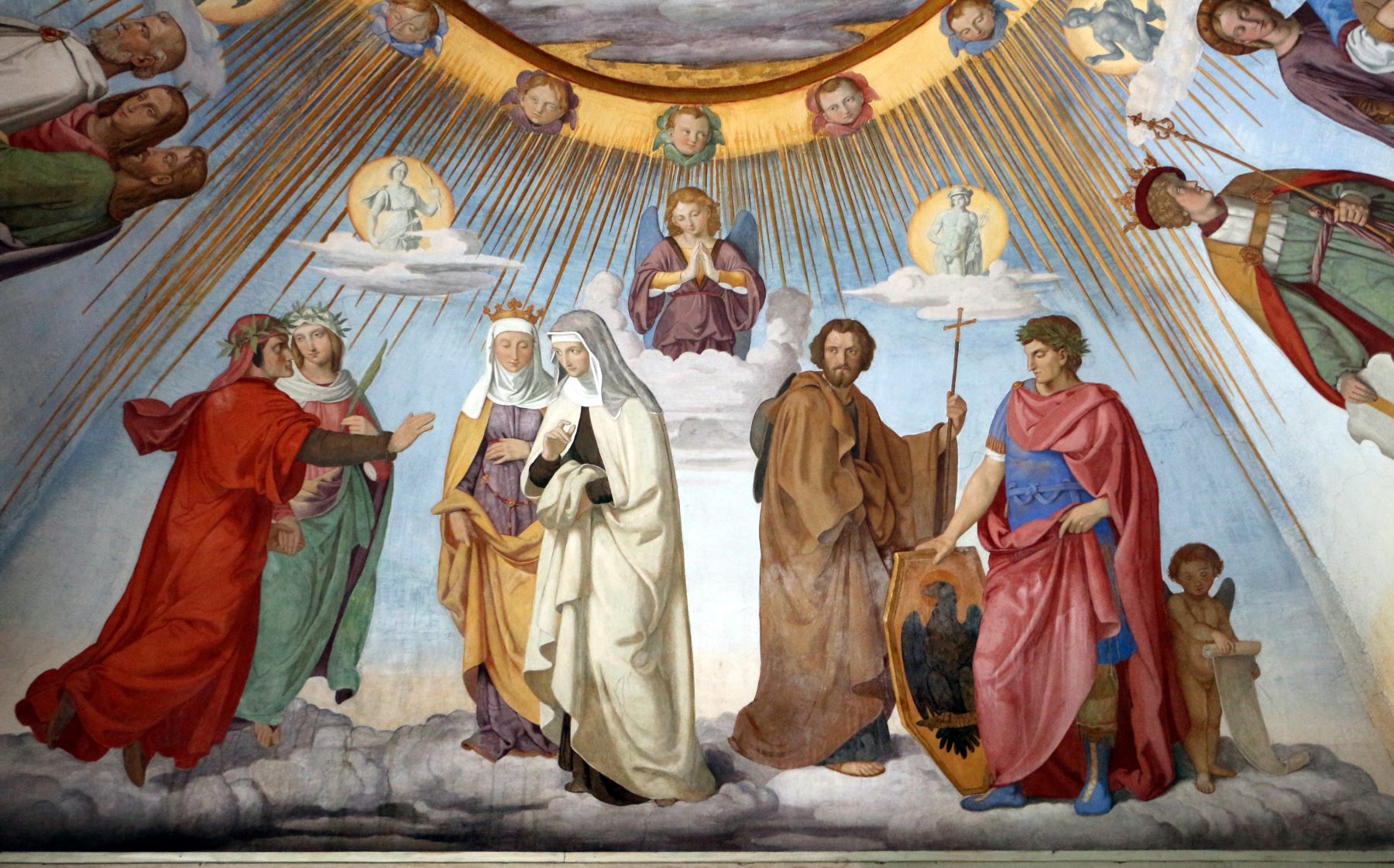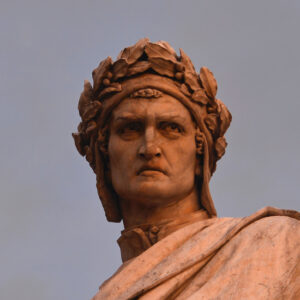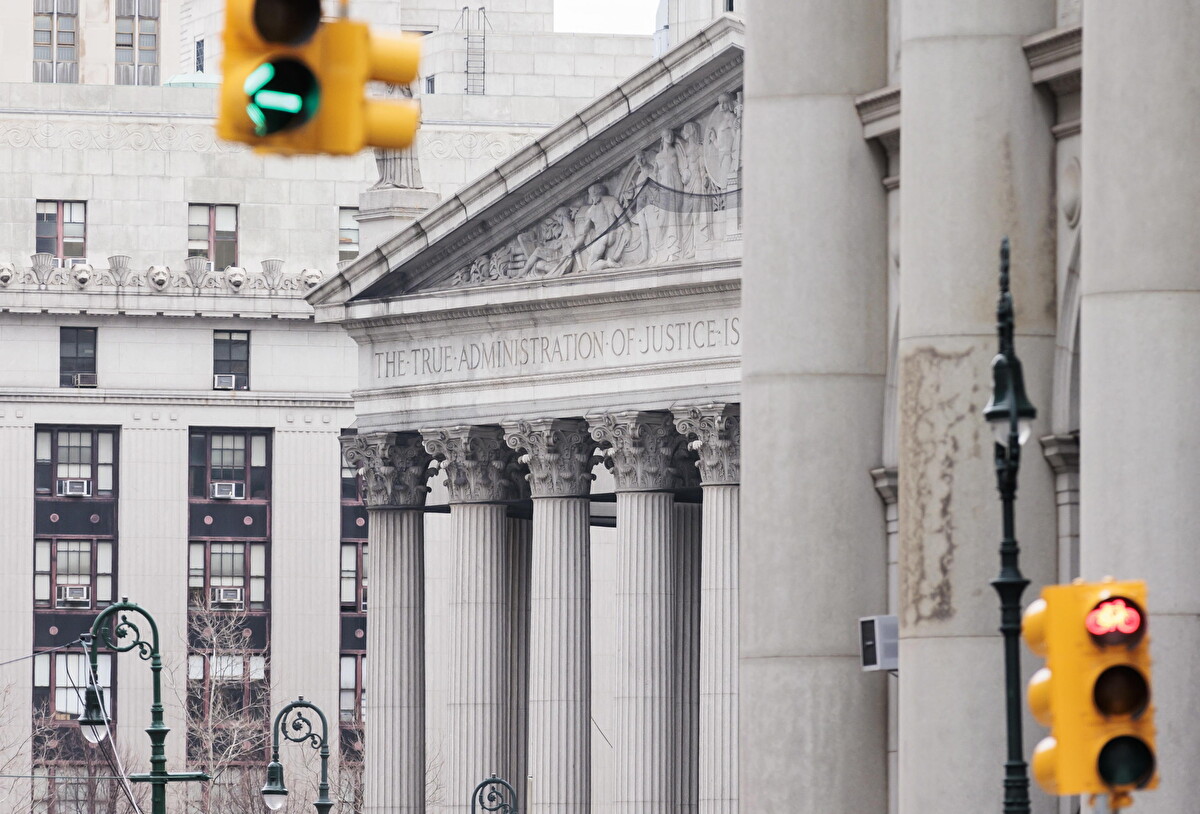Hailed as the father of the Italian language, Dante Alighieri (1265–1321) is best known for his Divine Comedy (Divina Commedia), penned between 1308 and 1321.
The work was revolutionary in that it was the first book to be written in Italian, known as the vernacular rather than Latin, the language of the elite. Although inspired by Homer’s great epic poems and Virgil’s Aeneid, Dante’s Divine Comedy chronicles a personal journey—his spiritual pilgrimage through the realms of Hell (Inferno), Purgatory (Purgatorio), and Paradise (Paradiso).
 In 1302, while Dante was in Rome as a delegate to the Pope, a new government was installed in his home town of Florence. Dante was accused of corruption and condemned in absentia. Thus began his lifelong exile. He moved from place to place, eventually living out his last years in Ravenna. It was this excruciatingly painful event that provided inspiration for this monumental work. In the seven centuries since its composition, the Divine Comedy remains one of the greatest literary accomplishments of all time, not only for its content but for its terza rima form (aba, bcb, cdc…), the structure of the cantos for which the poem is famed.
In 1302, while Dante was in Rome as a delegate to the Pope, a new government was installed in his home town of Florence. Dante was accused of corruption and condemned in absentia. Thus began his lifelong exile. He moved from place to place, eventually living out his last years in Ravenna. It was this excruciatingly painful event that provided inspiration for this monumental work. In the seven centuries since its composition, the Divine Comedy remains one of the greatest literary accomplishments of all time, not only for its content but for its terza rima form (aba, bcb, cdc…), the structure of the cantos for which the poem is famed.
Beyond the literary merits of the Divine Comedy the triptych overflows with insightful observations on the political and ecclesiastical upheaval that engulfed Dante’s native Florence in the Middle Ages. It presaged the emerging intellectual rumblings that would later become the Humanist movement and influenced the works of Francesco Petrarca, “Petrarch” (1304–1374), Giovanni Boccaccio (1313–1375) and Leonardo Bruni (ca. 1370–1444). Dante’s mastery of numerology has also been long appreciated by scholars. Throughout the poem, he makes numerous references to twelves; the apostles, sevens; the deadly sins, and threes; the Trinity.

Even today, the work has also attracted scientists looking for insight into the state of “scientific knowledge” in the early 1300’s, particularly the poet’s comments on physics and astronomy. Dante understood the spherical nature of the Earth, the placement of land masses upon it, the differing stars in the southern hemisphere and the nature of meridians. While he believed, as did Aristotle, that the Earth was the center of the universe, he attributed the movement of the nested spheres of the heavenly bodies to a divine system of celestial mechanics.

His study of time keeping devices–which were undergoing a revolutionary change from water-driven to mechanical, led to his commentary on the nature of time zones. In the ensuing centuries, Florence would become the center of map making, allowing for the known world to expand exponentially in the Age of Exploration.
With all this scholarly inquiry however, there remains yet another area worthy of note. That is Dante’s vast knowledge of gems and the emerging field of gemology. After the fall of Constantinople in 1204, Venice was the locus of the importation of products from the East, many of which were previously unknown or that had been rare and costly to acquire—silks and calicoes, spices and exotic produce, ivory, gunpowder, improved methods for glassmaking and precious stones. With its skilled cadre of goldsmiths, Italy quickly rose to preeminence as a center for stone setting.
From a gemological point of view, the Divine Comedy is a veritable treasure trove, containing pearls, rubies, topazes, emeralds, sapphires and diamonds, as well as crystal, amber and glass. Most of these gemological references can be found in the Paradiso, the Canticle of Light, in which Dante makes abundant use of illumination on objects in the form of reflection, refraction and shadow to convey a variety of metaphors and concepts—pearls, the intellectual luster of the wise; rubies, souls of Christian warriors; diamonds, fortitude and steadfastness; and the sapphire, emblematic of the Virgin Mary, Queen of Heaven.

Many of Dante’s metaphors are based on the unique reflective and refractive properties intrinsic to all gems. We now know that his poetic “illuminated” imagery was based on his understanding of the physics of light. He was most likely influenced by the ancient texts which were starting to emerge from monasteries and universities in the 1200s. Among them, particularly diffuse in Venice, were treatises on Euclidean and Pythagorean geometry which Italian gems cutters used to resolve complex problems such as the determination of angles, symmetry and the effect of light on a facet.
And now the largest and most luculent
Among those pearls came forward, that it might
Make my desire concerning it content.
(Paradiso, XXII. 28-30)
In this passage, the largest and most lustrous of the pearls, the precious spirit of St. Benedict comes forward to talk to Dante. As the father of monasticism in the Western Church, St. Benedict exemplifies the epitome of contemplative holiness—which stood in sharp contrast to the corruption of the Church Dante witnessed in his day. Because the pearl’s surface is round, it reflects light in a manner in which it appears to emanate from within. The soft radiance of a large, valuable, lustrous pearl is a fitting choice for such a mighty Christian leader.
Out of this river issued living sparks,
And on all sides sank down into the flowers,
Like unto rubies that are set in gold;
(Paradiso, XXX. 64-66)
The enduring beauty of the souls, which will continue to sparkle and retain their color and inner fire is exemplified in the use of gems as a vehicle for transforming the transient, fading beauty of life into the everlasting beauty of the soul as it is transformed by divine light.
It is evident that Dante was well aware of the intrinsic physical characteristics of each gemstone and its astrological association as well as the spiritual, metaphysical, and medicinal attributes each was purported to possess. His working knowledge of light’s reflection, refraction and dispersion on specific gems is extraordinary as he combines the thought process of a physicist with the words of a bard.










